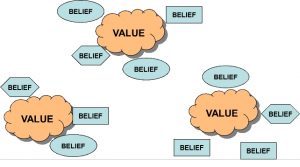You’ve probably heard the advice, “Recruit for attitude, train for skills”. It’s a warning against selecting someone on the basis of their exemplary technical or professional abilities only to find them “difficult” to work with. There’s then an assumption that you’re stuck with this situation until they leave or you’re forced to invoke disciplinary procedures.
Alternatively, if you take on someone with “the right attitude”, then you can teach them everything else.
The term “attitude” is used in several different senses. Among the dictionary definitions are: “a settled way of thinking or feeling” and “a position of the body indicating a particular mental state”. So it’s something inside, a mental or emotional state that can be revealed by posture or gesture.
Other definitions are “truculent behaviour” and “self-confident behaviour”. For example, “She snapped her fingers with attitude”, can be interpreted as deliberately causing difficulty or embarrassment to others or as expressing assertiveness, which is usually regarded as a positive thing.
It occurs to me that these ambiguities may persist in our language because they allow us to make statements that are more difficult to disagree with than the use of precise terms would. When your listener or reader can choose from several possible meanings for your words, then perhaps they tend to choose the one that best fits their own preconceptions.
The other thing to notice about “attitude” is that when used in the behavioural sense it is a “nominalisation”, i.e. it is a process or action that’s been turned into a noun or thing. So, rather than referring to what someone actually does, we refer to the attitude that they have. This makes it seem like a disease to be got rid of (if it’s negative) or like a gift or blessing (if it’s positive). In either case, we are distracted from considering what to do about the undesirable behaviour or from learning anything from the desirable.
I think that when we talk about another person’s attitude we’re usually referring to something they have that drives a particular kind of behaviour. So what is this “thing”?
 I suggest that attitude is a combination of:
I suggest that attitude is a combination of:
- values
- beliefs
- thinking styles (meta-programs)
“Values” and “beliefs” are terms that are often used interchangeably, so it’s helpful to distinguish between them as follows:
- Your values are what are important to you in a particular context. Now, while most of us would recognise abstract concepts such as “honesty”, “loyalty” and “justice” as values, I’d extend the meaning to include people and possessions. Their significance is that they drive behaviour – you generally pursue what you value. And it’s worth noting that, defined in this way, your values aren’t automatically good for you or for those around you. For example, you may come to realise that you are driven by a need for personal recognition and that this can cause you to pursue acknowledgement to the detriment of your relationships. As a value you might feel that you’d be better off without this one!
- Your beliefs are what you assume to be true, perhaps unconsciously. They cluster around your values and either reinforce or undermine them. So, if you believe that your self-justification, your self-esteem, depend on always being right then you will suffer the consequences of a severely limited range of responses. In particular, you won’t be able effectively to lead, coach or develop others.
The third component of “attitude”, thinking styles or meta-programs, is a collection of about a dozen different dimensions of thinking. Within each you have a preference for one end of the spectrum. For example, you tend either to be motivated towards achievement of goals or to be motivated to get away from pain. You may prefer to work with ever broader concepts or you may drill down into the details. You may look to others to help you to form your judgements or you may be guided exclusively by your own internal standards.
It’s important to note that we are all capable of thinking in any of these styles if we make an effort. Usually though we have a strong preference for one end of the range in each case.
So, can you change someone’s “bad attitude”?
Let’s consider the components.
Other people’s values are, in most situations, to be respected. If you look and listen carefully you’ll be able to get a good idea of what they are and then you can find opportunities to put them to positive use and to avoid situations where they’ll come into conflict. If someone finds the values of the organisation to be seriously at odds with their own then it may be best to accept that situation and to help them to make the inevitable choice.
Beliefs that limit behaviour represent the most fertile ground for change. You encourage this by challenging them in various ways, for example by asking the other to be specific when they voice a generalisation such as, “People are telling lies about me”. You could ask, “Who specifically told lies, and what did they say?” This will either reveal a genuine issue or expose a false belief.
You can do this with integrity and without manipulation because, in the end, the individuals make a choice for themselves.
With practice you can easily detect people’s preferred thinking styles and accommodate them. So, if you’re explaining your ambitious plans to an “away-motivated” person, expect them to raise objections and to look for problems. That’s what they do. You might talk about their problem-solving expertise and how much you’re going to need their help. That will appeal to them far more than the promise of future glory.
Finally, it’s important to remember that even the labels I’ve been using (values, beliefs, thinking styles) can lead you into the trap of thinking about the underlying mental processes as if they were immutable characteristics of a person. Keep this in perspective and anything’s possible!
How’s your attitude now?
By David Rawlings
 Email: david@changeworkcoaching.com
Email: david@changeworkcoaching.com




